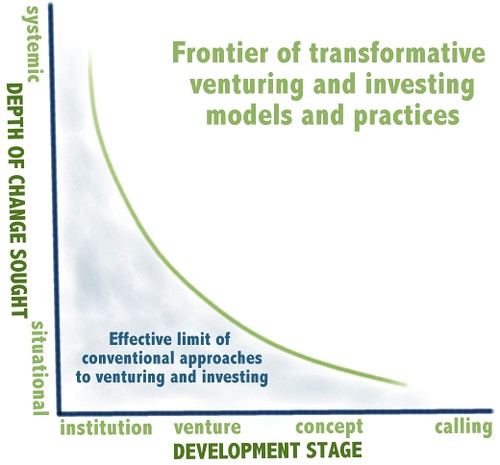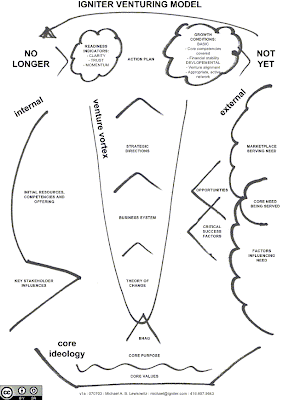I've been working my way through this tome for a few weeks and have had a number of conversations around it. It's by far the most valuable piece of work I've ever encountered on organizational design --- and for me a critical model in ventures that are on the venturing frontier (early concept stage and/or systemic co-creation -- see graph below).
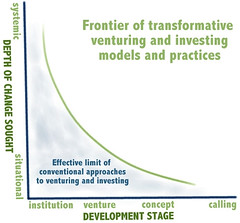
Written by Stafford Beer, this book is a thorough walk-through of the Viable System Model.
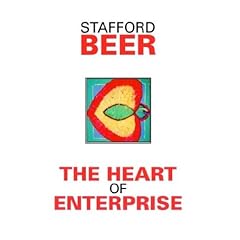
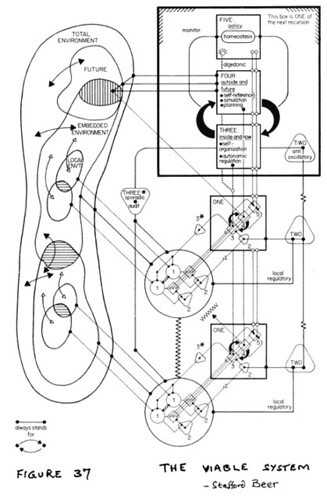
The key principles can be found here, but will not likely be that helpful without gaining an understanding of the language being used - which is a big part of why this book is so dense. It's also, I think, necessary though to get at this topic in a way that is freed from the conventions that most of us have learned and understand about management and venturing --- those same conventions that seem to fail us the earlier or more systemically focused the ventures are.
A potentially helpful excerpt in terms of practical application in day-to-day decision making can be found here but again the value will likely mostly be lost without an immersion in the language, theory, and examples contained in the book.
Rather than trying to summarize those - I have a lot more digesting and experimenting to do with this before I can begin to try - I will simply list a series of quotes that most interested me while reading the book. Perhaps that will help serve as some intriguing context.
(oh and by the way... I found the ones at the end to be the most fun).
+++++++++++
"... the viability of any enterprise. This is not meant in purely economic sense; it refers to the ability of the enterprise to maintain a separate existence."
"Every viable system contains, and is contained in, a viable system. This conept of an organizational nest is crucial to this account of how enterprises really work, and is contrasted with the orthodox concept of hierarchy."
"A System consists of a group of elements dynamically related in time according to some coherent pattern. ... this System has a PURPOSE ... (which) is you the observer of the System who recognizes its purpose. ... it means that we have to agree on the CONVENTION about the nature, the boundaries, and the purpose of any System before we can agree on what is to count as a fact."
"We cannot successfully handle any system that we are disposed to manage unless we obtain an insight into its nature. That nature, as we have seen, has to do with purposes, with boundaries, and with other matters which are not customarily investigated within our institutions..."
"Every Good Regulator of a System must be a Model of that System"
"Viable: able to maintain a separate existence."
"The metasystem exists to undertake whatever functions are required to procure coherence."
"At any point on the diagram, then, these orthogonal forces (operation, coherence) interact. It is that interaction with DEFINES FREEDOM within the viable system."
"The metasystem must make some intervention, and should make only that degree of intervention that is required to maintain cohesiveness in a viable system. Cohesiveness is however a function of the purpose of the system. ... Freedom is in principle a computable function of systemic purpose as perceived."
"For, if the systemic purpose is subjective, only agreement of the heart will justify a given level of cohesion in any institution."
"... the synergistic formula must lie in the intersect of all the elemental operations."
"... the cybernetic policy of freedom: minimal intervention, in aid of cohesiveness plus synergy."
"Of STRUCTURE there is almost nothing to say, beyond the 'machine for apportioning blame' that the organization chart comprises."
"When two models of each other converge, learning has occurred."
"Money can be made available, one way or another, sooner or later, so long as the system remains (and is observed to remain) viable. That is why I have previously described the availability of money as a constraint rather than as a condition. ... the really scarce resources need for this investment are those of time, talent, care, attention..."
"Closure is the talisman of identity."
"The very notion of recursiveness embraces the notion of local closure at any given level of recursion."
"... plans should be continuously adaptive to fresh information."
"Often some aspect of a matter is measured because that is the easiest aspect to slap a number on, and by now it is the traditional and the accepted thing to do."
"Figures are useful only to the extent that we use them."
"The measures we use do not have requisite variety to absorb the variety of that which they claim to measure."
"Fact: that which is the case."
"Noise: A meaningless jumble of signals."
"Data: statements of fact."
"Information: that which CHANGES us."
"Data become information - when the fact in them is susceptible to action. How can I possibly know that I am informed? -- Only because I have changed my state."
"a manager is a human being who has refined the brain's ability to recognize patterns, and to compare the key characteristics of such patters, in the context of extremely complicated systems comprising men, materials, machinery, and money;
he has become skilled in recognizing a change in his own state, by recognizing information in the data flowing around him and in the ambient noise;
he has the motive, and has cultivated the style, necessary to transduce his own change of state into a change of stat in the extremely complicated system of which he is the manager."
"The manager's job is three-fold: to set the CRITERIA of stability... ; to detect instability... ; to change the criteria."
"The manager's requirement of measurement is that it should measure stability and instability in the system that he (this being his role) has subjectively defined."
"The manager's information, however, is his own recognition of his own change of state."
"... the criteria to which the system answers, in terms of its degree of stability, derive from the criteria of systemic viability in the context of teh total viable system - and in particular they derive from the understanding of cohesion, in which... freedom and constraint are balanced to provide a workable level of autonomy."
"Improvement in the management of complicated systems will not occur until managers give up the dysfunctional concept of causality, and the search for the unique case."
Summarizing a few paragraphs here on what it means in terms of some measure for the system to say 'I am all right':
- we normally <e.g. produce>... speaks to status quo and is measured as ACTUALITY (actuality)
- our plan... speaks to intention and is measured as CAPABILITY
- we wish we could... expresses a will to advance and is measured as POTENTIALITY.
- Ratios of those then indicate degrees of stability: actuality to capability is PRODUCTIVITY; capability to potentiality is LATENCY; and actuality to potentiality is PERFORMANCE.
"... the (senior) manager... must listen to himself doing the job. Here is closure for the viable system. It also is a form of measurement. But it is self-referential, and there is no objective measure for a measurement so defined. In the viable system called 'the human being', this function is usually called conscience."
"Cohesiveness is the primary characteristic of organization."
"... the process of organizing itself creates a problem of fragmentation which only its capacity to provide cohesion can offset."
"... planning... is actually the 'glue' of organizational cohesion."
"... planning is a continuous process."
"What needs to be reiterated is that planning happens only when there is an act of deicision. This act commits resources now, so that the future may be different from what would otherwise have simply happened to us. It follows that the only planners are managers, namely those people who are entitled to commit resources."
"The argument is to say that planning is a continuous act of adaptive decision that continually aborts."
"...it is an act of decision carried out by managers empowered to commit resources to a different future. Planning is not an activity resulting in products called plans: it is a continuous process, whereby the process itself - namely that of aborting the plans - is the pay-off."
"Plans are the embodiment of intentions subscribed to at each level of recursion: since these intentions are constantly changing, and not in a homogeneous way with respect either to time or to probability..., they must continually abort. The only characteristic worth detecting, measuring, reporting, or doing anything about, is incipient instability in the system."
"The great physicist (Heisenberg) showed that to examine, to measure, to interrogate, something changes its state."
"The model we now have, contemplated at any one level of recursion, comprises two hierarchical stages - and only two. ... stage of operations inside and now, and there is the... stage that constitutes the metasystem."
"And it (senior management) should be characterized by calm."
"... infinity is a process; thus to understand the process is to understand infinity without going there."
"First: there is a very real barrier to modeling the recursivity of viable systems more than one system beyond that over which we have authority. Second: no finite model is possible, because we do not have requisite variety to make it; and all we can do is to contemplate the process whereby such models are endlessly capable of generation. And that is to define the infinite recursion; and that is to explode into self-consciousness."
"There are two features about instability that need a lot of careful consideration. The first is that instability may set in anywhere in the behaviour of the organization, and at any time. the second is that there are always pre-symptoms of the fact. Unfortunately, the typical management information system... is repetitiously reporting on stability - it is in fact challenging the manager to find evidence of this crucial instability in the welter of routine data. If, nonetheless, he finds it, he does so because instability has already set in - it is in fact too late to avert it."
"But suppose that we can acquire data about stability that can be transformed into infomration (which changes us) about the possibility, the likelihood, of incipient instability: then, and only then, do we have a chance to avert it."
"The causal model in a complex probabilistic system does not have requisite variety to predict the future. This can be said with confidence from many theoretical standpoints: epistemological, logical, even theological, as well as cybernetic - wherein the causal model cannot possibly exhibit requisite variety."
"It seems, may we not then say, that calm is a function of alertness. It comes from being poised to read the signs of incipient instability, in the quiet confidence that instability can be averted."
"The senior manager stands as he humanly is: a very finite person. But he holds many privileges, that can extend his human faculties: in expertise, through his staff and advisors; in space through telecommunications; in time through a monitored alertness to incipient instability - whenever it may come. He operates within a metasystem which, though its currency is conflict, generates a special and indeed unique comradeship."
"It is only in the infinite recursion that self-consciousness occurs. It occurs for the man himself, of course... .The senior manager has to embody the self-consciousness of the institution; even if, unhappily, he does not yet know himself... "
"But one feature of the management centre that is quite general has to e provision for the intercommunication of the senior managers that reflects the comradeship."
"It seems likely to me that people are very accommodating to a wide range of styles; what they reject in leaders is especially insensitivity and insincerity."
"The problem is that managers are themselves, and tend to use the response they see fit and the style they see fit as if these two things were unconnected. The variety analysis leads to the conclusion that this is not so."
"The two immediate consequences of these arguments are, first that it is better to teach a manager to know himself than to know what someone supposes (without knowing the circumstances) that he ought to be; and, second, that he should understand the systemic nature of the viable system in which he operates."
"The final diagram shows us how everything is modifying everything else. Its contemplation is rewarding, because it finally demonstrates the foolhardiness of reductionism in senior management."
"If we want to classify the situations in which the manager finds himself, they are dependent on two major parameters. ... The fist of course is variety, and the second is relaxation time."
"Thus in designing a regulatory system for any given situation, the first rule is to follow every significant loop through the systemic diagram, applying the variety rules that have been elucidated. The second rule is to attend to the relaxation time of the system. ... The key point to note is that if the system has not returned to stability before another shock drives it once more towards instability, then the regulation is impossible. So is learning impossible, so adaptation, so evolution."
"The real concern is with the proliferating variety that must needs be absorbed; and with the time that must needs elapse before the iterative loops of the managerial system can assimilate that variety and return the representative point of the system to stability and the psychological state of the manager to its point of calm."
"The parameters of effectiveness... judgment, style, and relaxation time..."
"... we observe him (the senior manager) as personifying the self-consciousness of the enterprise. The clue was that he operates in the awareness of the infinite recursion."
"If the senior manager success in understanding, and legislating for, his own ambiance of calm and alarm; and if he also succeeds in classifying managerial situations and his own decisions according to the tripartite model here set out (judgment, style, and relaxation time), then he may operate closure in the sense defined. And if he does that, in full awareness of what he is doing, then he may embody the infinite recursion as a living process."
"Perception fo the infinite recursion is always the goal. Perhaps the problem is that once a man or woman has reached that perception, nothing matters any longer."
"The contention seems to be that if the informational system is properly deisnged to recognize incipient instabilities, and if there is a management cnetre in which requisite metasystemic variety is shared between comradeship, then the senior management can become aware of what it is really doing."
"... viable organizations produce themselves."
"It is extremely important, when contemplating what it is to count as the management centre, to consider the inter-recursive algedonic signaling equipmnent. Otherwise: either the management centre will go to sleep in trance-like contemplation of the self-consciousness of the infinite recursion, or it will be overtaken by anarchists from the lower recursive levels intent on alleviating their personal pain."
"The suspicion dawns that the enterprise may not only be a system that produces itself, but that this is both its definition and its purpose."
"The heart of the enterprise is embodied in its own people. Consultants cannot catalyse interactions that do not exist, or are persistently and perversely held at bay."
"Life is a process, not a justification."
Blogged with Flock
